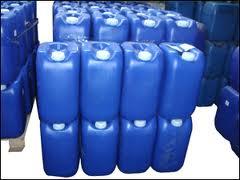Lactic acid
| Infobox on Lactic acid | |
|---|---|
| Example of Lactic acid |  |
| Facts | |
| Origin | - |
| Stowage factor (in m3/t) | - |
| Humidity / moisture | - |
| Ventilation | - |
| Risk factors | See text |
Lactic acid
Description
Lactic acid, also known as milk acid, is a chemical compound that plays a role in various biochemical processes. Lactic acid is a carboxylic acid with the chemical formula C3H6O3. It has a hydroxyl group adjacent to the carboxyl group, making it an alpha hydroxy acid (AHA).
In solution, it can lose a proton from the carboxyl group, producing the lactate ion CH3CH(OH)COO−. Compared to Acetic acid, its pKa is 1 unit less, meaning lactic acid deprotonates ten times as easily as acetic acid does. This higher acidity is the consequence of the intramolecular hydrogen bridge between the α-hydroxyl and the carboxylate group, making the latter less capable of strongly attracting its proton.
Lactic acid is chiral and has two optical isomers. One is known as L-(+)-lactic acid or (S)-lactic acid and the other, its mirror image, is D-(−)-lactic acid or (R)-lactic acid.
In animals, L-lactate is constantly produced from pyruvate via the enzyme lactate dehydrogenase (LDH) in a process of fermentation during normal metabolism and exercise. It does not increase in concentration until the rate of lactate production exceeds the rate of lactate removal, which is governed by a number of factors, including monocarboxylate transporters, concentration and isoform of LDH, and oxidative capacity of tissues. The concentration of blood lactate is usually 1–2 mmol/L at rest, but can rise to over 20 mmol/L during intense exertion.[citation needed]
In industry, lactic acid fermentation is performed by lactic acid bacteria converting glucose and sucrose. These bacteria can also grow in the mouth; the acid they produce is responsible for the tooth decay known as caries.
In medicine, lactate is one of the main components of lactated Ringer's solution and Hartmann's solution. These intravenous fluids consist of sodium and potassium cations along with lactate and chloride anions in solution with distilled water, generally in concentrations isotonic with human blood. It is most commonly used for fluid resuscitation after blood loss due to trauma, surgery, or burn injury.
Lactic acid is colourless or yellowish, odourless, hygroscopic, syrupy liquid. Miscible with water, alcohol, glycerol and furfural; insoluble in chloroform, petroleum ether, carbon disulfide.
Application
Cultured dairy products, as acidulant, chemicals (salts, plasticizers, adhesives, pharmaceuticals), mordant in dyeing wool, general-purpose food additive, manufacture of lactates.
Shipment / Storage / Risk factors
See: http://www.chemicalland21.com/lifescience/foco/LACTIC%20ACID.htm











